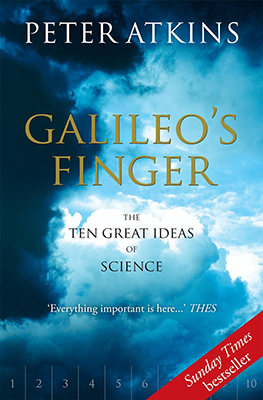Galileo’s Finger
“Galileo’s Finger: The Ten Great Ideas of Science” is a book written by Peter Atkins, a chemist and former professor of chemistry at the University of Oxford. Published in 2003, the book explores ten fundamental concepts or ideas in science that have shaped our understanding of the natural world. Here’s a summary of the key ideas discussed in “Galileo’s Finger”:
Law: Atkins begins by discussing the concept of laws in science, such as Newton’s laws of motion or the laws of thermodynamics. These laws describe fundamental principles that govern the behavior of matter and energy in the universe.
Probability: The book explores the concept of probability and its role in understanding uncertainty and randomness in natural phenomena. Atkins discusses how probability theory is applied in various scientific disciplines, from quantum mechanics to genetics.
Entropy: Atkins delves into the concept of entropy, which relates to the measure of disorder or randomness in a system. He explains its significance in thermodynamics and its implications for the arrow of time and the universe’s eventual fate.
Quantum: Quantum mechanics is a central theme in the book, focusing on the revolutionary theories that describe the behavior of particles at the atomic and subatomic levels. Atkins explores concepts such as wave-particle duality, uncertainty principle, and quantum entanglement.
Space: The book discusses the nature of space and its exploration through scientific theories and observations. Atkins examines how our understanding of space has evolved from classical mechanics to Einstein’s theory of relativity and modern cosmology.
Time: Time is another fundamental concept explored in the book, from its measurement and perception to its role in physics, including theories like relativity and the possibility of time travel.
Chaos: Atkins explores chaos theory, which deals with complex systems that are highly sensitive to initial conditions. He discusses how chaotic behavior can emerge from deterministic systems and its implications for understanding natural phenomena like weather patterns.
Structure: The book examines the concept of structure in science, from the atomic and molecular level to the cosmic scale. Atkins discusses how scientists uncover and analyze the structure of matter, from DNA molecules to galaxies.
Cosmology: Atkins delves into cosmology, the study of the origin, structure, and evolution of the universe. He discusses theories such as the Big Bang theory, dark matter, and dark energy, exploring our current understanding of the cosmos.
Evolution: Finally, the book discusses evolution by natural selection, Charles Darwin’s groundbreaking theory that explains the diversity of life on Earth. Atkins explores how evolution operates through genetic variation, adaptation, and natural selection.
“Galileo’s Finger” is structured around these ten ideas, offering readers a broad overview of key concepts in physics, chemistry, biology, and cosmology. It aims to provide a deeper understanding of how science works and how these ideas have shaped our understanding of the natural world and our place within it.

